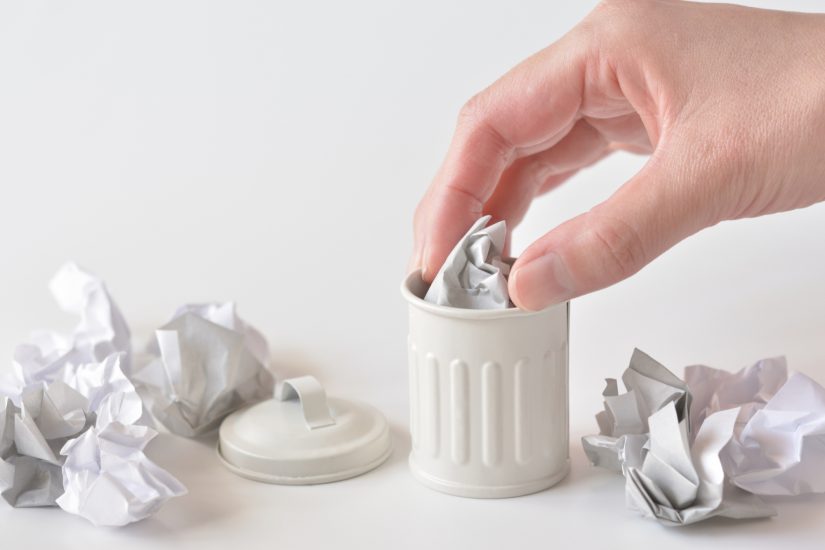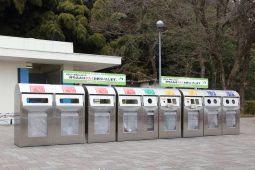Although rules for trash and garbage disposal can vary across Japan depending on the prefecture or locality, generally speaking, domestic trash is separated into burnable and non-burnable waste. Recyclable waste consists of plastic bottles known by the acronym PET which stands for “Polyethylene terephthalate” — a form of polyester, but also of glass bottles and jars, as well as aluminum food and drink cans. Any given week in your locality is likely to have one day set aside for collecting recyclable waste and two days for regular domestic trash. There may also be a day set aside for collecting oversized garbage and electrical appliances, but in many cases, you are not permitted to leave such waste in the garbage collection area, and instead will have to pay a company to dispose of it, or take it yourself by car or truck to a local recycling center.
Many companies that collect oversized garbage leave calling cards in home letterboxes. These accumulate over time giving you what seems like a variety of companies to choose from. Be aware, however, that the different phone numbers on these calling cards are likely all linked to the same company’s contact center, and with such a monopoly, its prices are consequently very expensive! A cheaper option is to keep an eye out for a local collector in a rickety truck who may pass by regularly. These individuals may offer to collect your oversized garbage at a more reasonable price. When Japanese housewives hear the tannoy system advertising garbage collection services, they go out onto the street to flag the truck, which drives at a snail’s pace, down. Electrical appliances such as fridges and televisions cost more, however, as they are heavier items, and recycling centers charge to recycle oversized waste based on the weight. Still, for cost-effectiveness nothing beats taking your oversized waste to your local recycling center by yourself or with help from friends, colleagues or family — especially if you have many items. Even taking into account the cost of renting a car or small truck if you don’t have one of your own, this option is the cheapest.
Separating and sorting regular domestic trash can be a pain, but it’s definitely worth it. In the hot and humid Japanese summer, it only takes a day for food waste to go bad and stink to high heaven. That’s one of the reasons garbage sorting rules ask householders and residents to rinse or wash out food residues from containers before throwing them out. In English, we talk about “throwing out” the trash/rubbish, but in Japanese the haphazard image of just “throwing” garbage away doesn’t exist. This is one of the top complaints that older Japanese residents sometimes have about “foreigners” — but really, many young Japanese singles and families are just as bad at not sorting out their garbage according to the precise rules drawn up by local municipalities. In most countries other than Japan or Germany, it seems that regular domestic trash is lumped together before being sorted by workers at waste disposal sites rather than separated and sorted by the residents themselves. This leads people from other countries to adopt quite a casual attitude to “throwing out” the trash which can be at odds with how Japanese neighborhoods see the issue.
While it’s not just foreigners who can’t or don’t follow the rules for domestic trash disposal, I remember my younger days in Osaka and how a lack of knowledge of the rules, tiredness from long hours at work and poor organization combined to prevent me sorting out my garbage exactly as was requested. This usually resulted in a note being left on my trash in large red letters requesting that it be left out on the correct day or separated properly.
With the above in mind, here are some tips to make trash disposal easier:
1. Buy a trash can for the kitchen with at least two separate compartments (preferably three). These purpose-made waste containers are designed to help you separate your trash into burnable, cans/glass and PET bottles. They also have handles from which you can hang plastic bags to further separate everything.
2. PET bottles have labels designed to peel off easily before disposal — look for the dotted line. The caps also need to be removed and added to other plastic waste.
3. Glass, can and plastic containers need to be rinsed out before disposal.
4. Some localities require that plastic garbage bags are see-through, so that waste can be easily identified by the person who sorts out everyone’s trash on collection days. These bags are readily available in your local Japanese drug store or supermarket.
Have fun sorting out your trash folks!








